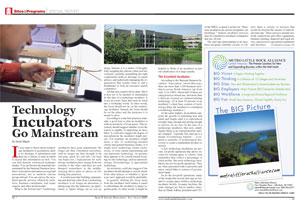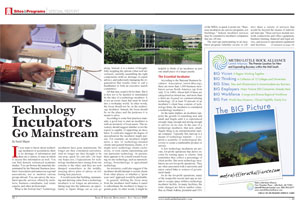

If you want to know about technology incubators, or accelerators, there is no shortage of information. You can find densely referenced academic studies. You can browse the materials disseminated by the Nation Business Incubator Association and numerous regional associations, not to mention various groups abroad. You can survey the incubator-specific services offered by architects, business consultants, real estate experts, and other professionals.
The bottom line? Technology incubators have gone mainstream. No longer are they considered curiosities. And no longer are they thought to be one-stop quick-fix cure-alls. (At least one hopes not.) Expectations for technology incubators have swung from one extreme to the other, and they are now damped somewhere in the middle, swaying above piles of advice on following best practices.
It would seem that building, maintaining, and deriving value from a technology incubator is no longer an adventure, a daring leap into the unknown, an opportunity to figure things out as you go along. Instead, it is a matter of thoughtfully weighing the options (often well advertised), carefully assembling the right components (with no shortage of expert advice), and judiciously managing the organization that results (time to call a headhunter or form an executive search committee).
All that may sound a bit ho-hum. But it is best not to be dazzled or intimidated by the idea of a technology incubator. It is not an exotic beast that must be lured into a workaday world. In other words, the focus should not be on the technology incubator. Instead, the focus should be on the place and the purposes it is meant to serve.
According to some best practices manuals, a good way to start an incubator is with an inventory of local assets. This inventory should suggest whether or not the region is capable of supporting an incubator. It could also suggest the degree of specialization the incubator might pursue. For example, an incubator might serve a mix of technology-oriented clients and general business clients, or it might serve technology clients exclusively, or even clients representing just one particular technology. At present, there appears to be a trend toward focusing on one technology, such as nanotechnology, biotechnology, or agricultural technology.
An inventory could also suggest if the incubator should attempt to recruit clients from other places, or whether a “grow your own” approach would be preferable.
In general, shifting the focus away from the incubator itself makes it easier to subordinate the incubator to larger regional goals. In other words, it might be helpful to think of an incubator as just one small piece of a larger puzzle.
The Essential Incubator
According to the National Business Incubator Association (www.nbia.org), there are more than 1,000 business incubators across North America (up from only 12 in 1980). About half of these are categorized as mixed-use, and more than a third are focused on commercializing technology. (If at least 50 percent of an incubator’s client base consists of technology firms, the incubator is considered a technology incubator.)
As the name implies, an incubator supports the growth of something new and small and fragile until it is experienced enough, large enough, and strong enough to survive on its own. In the case of a technology incubator, that new, small, fragile thing is an entrepreneurial start-up company. Typically this start-up is a means of technology transfer — it exploits a scientific or technological discovery to create a marketable product or service.
A few technology incubators are private, for-profit operations that derive income by renting space to clients. And sometimes they collect a percentage of client profits. But most technology incubators are not-for-profit operations. They are often associated with a university and enjoy varied links to sources of government funds.
As do the for-profit operations, many of the nonprofits recruit start-ups as tenants to occupy space within a technology incubator facility. In many facilities, the rents charged are below market value. But, as Dinah Adkins, president and CEO of the NBIA, is quick to point out, “Business incubators are service programs, not buildings.” Indeed, incubator services may be extended to incubator companies that are off-site.
The start-ups participating in an incubator program (whether on-site or off-site) share a variety of services that would be beyond the means of individual start-ups. These services include network connections and office equipment, business training, financial and legal advice, and access to specialized equipment and facilities. (In the case of biotechnology start-ups, available resources may include wet labs.) And, since many incubators are associated with a university, many incubator start-ups enjoy access to libraries and university faculty and students, who may betaken on as consultants.
Most incubators shelter start-ups for about three years. After this period expires, the fledgling company is said to graduate. The trick, from an economic development standpoint, is to have the graduates settle nearby, in the region, eventually providing jobs to area residents.
On this point, statistics from the NBIA are encouraging. This organization’s studies suggest that 84 percent of incubator graduates stay in their communities. In addition, incubator graduates have a good survival rate. In a University of Michigan study, about 87 percent of incubator graduates were still in business. And, at the time of the study, most had been in business for at least five years.
What About the Jobs?
Although incubator companies fare better than non-incubator start-up and growth companies in terms of initial survival, it is unclear how well they perform as job-creation engines. Early-state incubator companies rely on just a few highly trained professionals with advanced degrees. As they approach the production stage, incubator companies may hire a few people with less impressive academic credentials. But only after the production stage is reached will hiring encompass the ordinarily skilled, that is, people with general office, production, or distribution skills.
And there is always the possibility that an incubator company will avoid a production role, and instead license its technology to another, possibly distant company. This other company will provide broader employment, while the incubator company remains a research or design house.
According to the NBIA, North American incubator client and graduate companies have created about half a million jobs since1980. And the NBIA estimates that in 2005 alone, North American incubators assisted more than 27,000 start-up companies that provided full-time employment for more than 100,000 workers and generated annual revenue of more than $17 billion.
These statistics, however, do not indicate how many jobs might have been created if the resources devoted to incubators had been allocated differently. To be fair, the recent surge in incubators is difficult to assess. And the maturation of the incubator trend, which is apparent in efforts to define benchmarks and best practices, may produce lasting improvements.
If so, the incubator trend may overcome lingering skepticism. Those skeptical of the incubator trend include those who remember conspicuous failures. For example several incubators that focused on information technology failed during the dot-com meltdown. Also, an incubator in New Haven, Connecticut was cited in several news accounts as a disappointment. This incubator, with its proximity to and associations with Yale University, seemed to have everything going for it. Yet, while the incubator produced promising graduates, these graduates tended to relocate elsewhere when it was time to expand.
Another dimension of overcoming skepticism has nothing to do with hard numbers. Rather, it involves simply cultivating good relations with the community. For example, some incubators make a point of booking frequent tours as one way to keep local supporters “in the loop.”
A New Game
One way to understand the current appeal of incubators is to review their origins. An early incubator, possibly the first, started in Batavia, New York, in 1959. The concept represented by this incubator caught on slowly. At first, the concept was largely a Northeast phenomenon.
The typical incubator was an attempt to mitigate the loss of a large manufacturer. (In many instances, the manufacturer had relocated to a less expensive region of the country.) Local authorities would subdivide the large facilities abandoned by the exiting manufacturers.
Today, the incubator trend extends throughout the country. It is conceivable that the trend is a reaction to competition for large manufacturers, which may not only be attracted to other regions in the country, but other nations. Everyone is feeling the pressure of general de-industrialization. And rather than engage in increasingly fierce competition to offer the lowest costs and biggest incentives to lure whatever large manufacturers remain, many localities are experimenting with an alternative approach. Rather than swinging for the fences, they are hitting singles, bunting, and playing a running game.
For years, the economic mantra has been that resisting our sourcing and offshoring is futile, and that the appropriate response is to move up the value chain, pioneering new technologies and embracing knowledge-intensive processes and operations. For better or worse, the incubator phenomenon may be an attempt to play this game. Over the long term, will jobs created by incubator graduates stay close to home?
Some suggest that the incubation process naturally creates networks of people and institutions that embed companies within a region. Others seem less willing to leave embedding to chance. They advocate more or less formal mechanisms to keep incubator companies close to home. For example, it may be possible to contractually require companies that receive incubation services to remain in the area once they grow and reach the manufacturing stage. It may be possible to attach first source hiring agreements to firm-specific incentives so that area residents get the first chance to qualify for available jobs. And it may be possible to require university partners to share royalty and licensing fees with governmental bodies that support incubators.
A less formal (and more regionally minded) approach is to promote the development of places for incubator graduates to move when it is time for them to expand. In other words, the development of technology incubators could be undertaken in tandem with the development of technology parks. A technology park is distinct from a technology incubator.
According to the NBIA, technology parks tend to be larger-scale projects than business incubators. They may span many acres or miles, housing everything from corporate, government, and university labs to big and small companies. Research parks typically do not offer business assistance programs. But some technology parks house incubators.
Technology Incubators Recognized by the NBIA for Stimulating Conspicuous Growth in Employment and Revenue*
|
|
|
|
|
|
|
|
|
|
|
|
|
|
|
|
|
|
|
|
|
|
|
|
|
|
|
|
|
|
|
|
|
| |
|
|
|
|
|
|
|
|
|
|
|
|
|
|
|
|
|
|
|
|
|
|
|
|
|
|
|
|
|
|
|
|
|
|
|
|
|
|
| Revenue |
|
|
|
|
|
*This table is adapted from information originally presented by the National Business Incubator Association (www.nbia.org).
